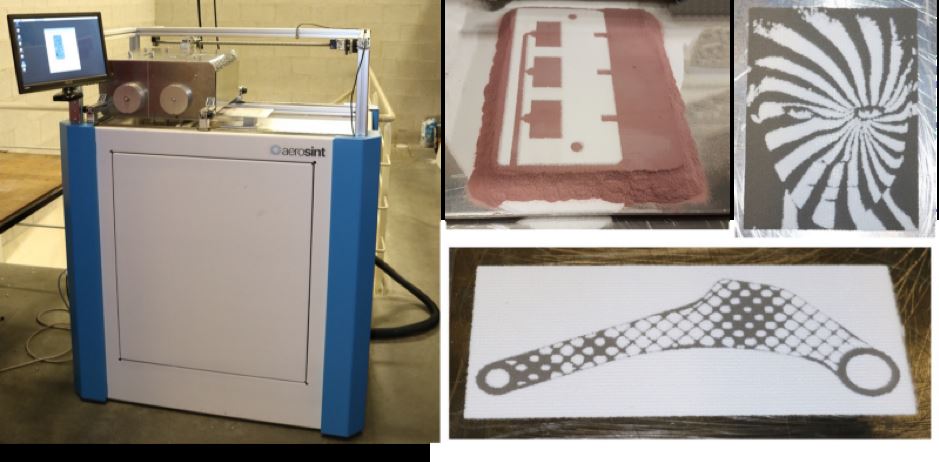![Powder recoater prototype (left). Multi-material powder layers created with the prototype (right) [Image: Aerosint]](https://fabbaloo.com/wp-content/uploads/2020/05/aerosint1_img_5eb09be15f4f4.jpg)
Aerosint and Aconity are collaborating toward a multi-metal future for 3D printing.
Belgium-based Aerosint has been working for several years now on an interesting take on multi-material laser powder bed fusion (LPBF) (SLS-style) 3D printing. Last summer the company got a boost with an €850K investment to speed up development and work toward marketability.
They have developed a modular approach, creating a recoater that can be integrated into existing LPBF systems. So partnering with a hardware company is a strong step toward realization.
The partnership is set to bring the recoating tech to the AconityONE 3D printer. Aerosint says that its “patented powder voxel deposition technology makes it possible to recoat multi-material powder layers. By applying the right energy source to the multi-material powder layers, compatible materials can be fused together to create multi-material parts.”
For its part, Aconity will then “do research on compatible metals and identify the appropriate process parameters for co-fusing of those materials.”
Multi-metal 3D printing like this is a new step for the industry.
The companies are hoping to ultimately make their joint work not only viable, but available. They say:
“If meaningful applications are developed as a result of this joint research, the Aerosint module will in the future also be made available to Aconity’s customers on the machines options list.”
This type of development is exactly what we’ve been hoping to see in 3D printing in 2019.
For more details into what we can expect to see, and how these two companies came to work together, I spoke with Aerosint’s Managing Director, Edouard Moens de Hase, and Aconity’s CEO, Yves Hagedorn.
From Aerosint’s perspective, the partnership is important “because we are building,” Moens de Hase said in opening.
“We have reinvented one part of the machine, the recoating element, so we need to partner with machine manufacturers to integrate into their systems, and sell to their customers,” he continued. “The system can be used in different ways and applications, one of the important applications we have identified is multi-metal. In the beginning, dual metal, combining two metals in one part.”
Aerosint has been working with Fraunhofer on their technology for several months, he noted. The work with Aconity is a step forward, toward a potentially commercializable route for the selective powder deposition technology.
Initially, at least, the partnership is founded on research; the pair acknowledged that there remain “challenges to be solved.”
On the powder deposition side, Aerosint values the expertise in materials and processes that Aconity has built up. Understanding the properties of the metals and processes at play are necessary, and “co-fusing of different metals together in one part” means “a lot of challenges there,” Moens de Hase said.
“Multi-material has always — ever since I’m in the industry, for over 10 years now — been a topic of potential interest to quite a lot of customers,” Hagedorn explained. “This is a wide application that has so far been missing. Multi-material needs to be pushed from the technology side. We have created showcase parts, that can be made out of potentially two different metals, that spark inspiration in customers.”
Especially interesting from Aconity’s perspective is the modular setup. This allows for one relatively simple (once the tech’s in place, that is) integration to significantly expand capabilities.
The Aconity platform specifically is a good fit for Aerosint’s powder recoating tech, Moens de Hase continued, “because the machine has some technical flexibility that others maybe don’t have.” The size of the system is relevant here, as “this recoater is a big recoater” and the AconityONE “is already quite a big machine.” The machine’s dimensions are billed at 3000 x 1700 x 3000 mm.
Turning back to the partnership, Hagedorn added that an important aspect is that both companies “are driven by applications.” That means close communication with users and potential users — which in turn means ensuring that realities are kept in mind.
“I don’t want to have the market thinking now that we have a solution for multi-material additive manufacturing at once,” Hagedorn said. “What we know is that we have the tools here, and now we want to raise awareness that there are competent partners for customers with real applications.”
While the promise of multi-metal powder bed printing is intriguing, and could open up a good range of applications — it’s still actively in development.
“This is the first building block of a relationship that could grow in the future,” Moens de Hase said. “Most importantly, as Yves said, is the market for it. If we do something together and drive this relationship, it will be driven by customer demand.”
The applications focus means a focus on the real world.
In part two of this interview, we’ll look into some strong points these new partners raised about collaboration in a fast-growing industry.











Aerosint and Aconity have proven out their work in multi-metal powder deposition 3D printing.